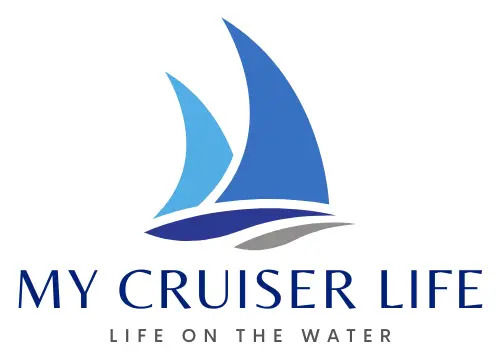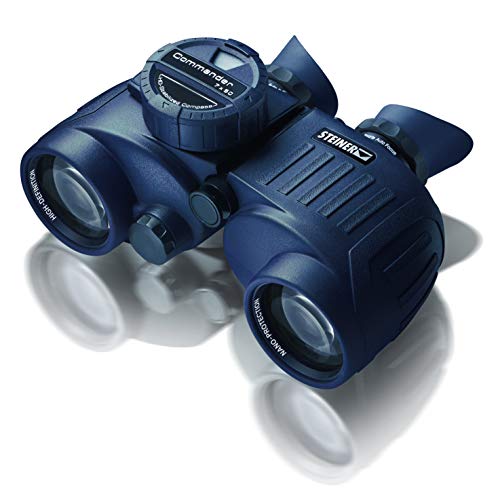It’s hard to imagine a sea-faring captain standing at the helm of his tall ship and barking orders to his swabs, without seeing a collapsable brass telescope, or spyglass, in his hand.
We sail small ships these days, and we usually have fewer swabs to order around. But we do keep a brass telescope close at hand. Well, not really. There have been a few technological advances in the last 300 years. Today, the modern equivalent is the ever-trusty and reliable marine binoculars.
Table of Contents
- Why are Binoculars for Boaters Important?
- Understanding Binocular Specs
- Features to Zoom-In On – Best Binoculars for Boating
- How to Choose Marine Binoculars
- Best Boat Binoculars Brands
- A Few Marine Binoculars Reviews
- The Marine Binocular – A Important Part of Your Skipper’s Toolkit
- Binoculars for Boating FAQs
Why are Binoculars for Boaters Important?
So, what are we always so busy looking at? In general, everything! From the deck of a moving boat, small details easily blur together, and it becomes difficult to focus on distant objects. Binoculars help us spot tiny distant objects with ease.
General Boat Binoculars
All boaters use binoculars to some extent. There are three primary purposes that this captain can think of, but your mileage may vary.
1. Collision Avoidance
The rules of the road clearly state that every vessel must maintain a proper look-out, by sight and sound, to ensure that they do pose a collision hazard to other vessels. To this end, binoculars are of huge help.
While on watch, you’ll often see some clue of another vessel on the horizon. Perhaps it is a bit of smoke trailing behind a container ship or the sails of a sailboat of different types. Your binoculars will likely resolve the object for a positive identification, and you can usually get an idea if it’s headed in your direction much sooner.
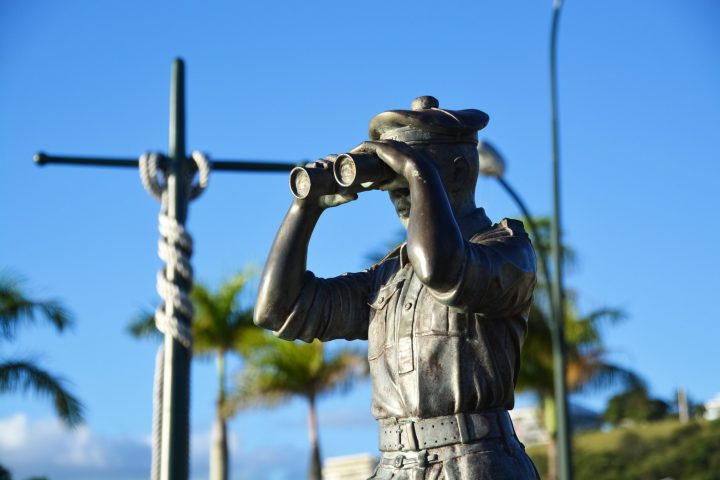
This is doubly true at night. Ships and boats carry navigation lights for the same purpose–to make them visible and to help you identify if they pose a collision hazard or not. But at night, it can be impossible to tell the difference between a huge ship 20 miles away and a small boat 2 miles away. The only way to solve this is with binoculars.
Furthermore, many vessels have other lights on their decks and shining out their windows. Binoculars will help you determine where the vessel’s navigation lights are and which colors you see. Then, you can determine if you need to take evasive action or not.
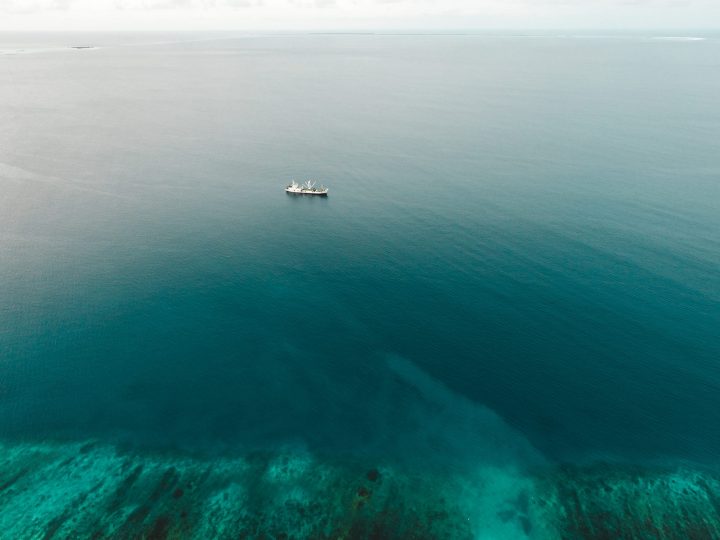
2. Landmarks and Navigation
Just like boats, landmarks can be difficult to see. Sea buoys and markers on pilings are probably the most often searched for items with a pair of ocean binoculars. You’ll be making way towards some point marked by one of these things, and you’ll want to see it visually to confirm what the charts and GPS are telling you. Also, you might need to turn off your sailboat autopilot to get there faster.
In the case of a large sea buoy, you can usually see them with the naked eye from about a mile away. On days with rough seas, it might be very hard to see it, however. Binoculars can extend that range to three miles or more and help you spot it on the waves.
Daymarkers on inshore waterways are also hard to spot. They easily blend in with the land in the background, making it very hard to spot until you’re right on top of it. Since these daymarkers are your primary navigation method that also helps to avoid boat accidents, it’s vital that you see them as soon as possible and don’t get confused between different markers.
Beyond just spotting the marker, knowing precisely which marker you’re looking at is important. You see a green buoy, but is that Green 3 or Green 1? The difference might mean being safely in the channel and being aground for a few hours. There’s no way you’ll be able to tell the difference between “3” and “1” without an excellent pair of boating binoculars.
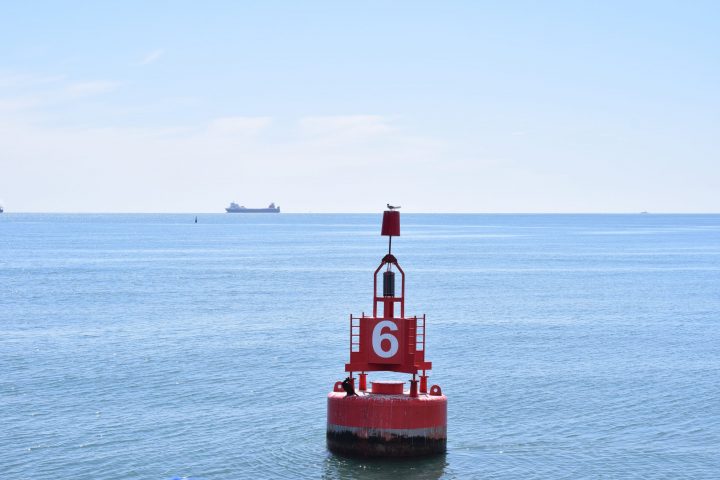
3. Looking at Cool Stuff
This one might not sound too “captainy,” but it’s the truth. Binoculars are fun to have aboard so you can look at cool stuff. Dolphins playing in the distance, rare birds wading in the shallows, or bonefish finning off the beach are some natural examples. Or maybe you’re sharing the harbor with a beautiful yacht or a sailboat, and you are trying to make out its name to look it up online later and see who owns it. Or maybe you’re cruising offshore and a nearby fisherman hooks into a sailfish, and you want a front-row seat to the action. Maybe it’s after dark you want to enjoy that full moon a little closer.
The options are nearly limitless, and they’re all up to the skipper and crew. Our binoculars stay at the helm 24/7, always within reach for whatever it is we want them for.
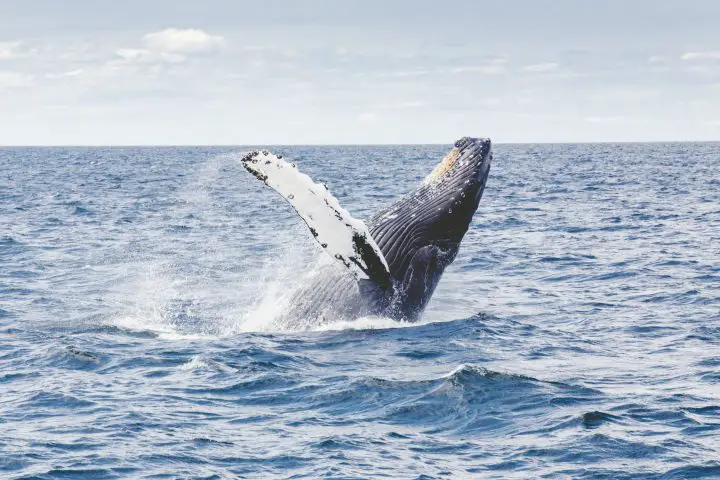
Sailing Binoculars
Sailors need a good pair of binoculars and a good pair of sunglasses for boating to help them perform the same tasks. In general, a pocket cruiser sailboat may spend more time offshore, so they may be more interested in looking at landmarks to make the right landfall.
Far offshore, landmasses provide great information to support your other navigation techniques. For example, you may have dead reckoned your way across Chesapeake Bay, but you won’t have a positive idea of where you are until you can identify something on land and match it with something on the chart. For this reason, charts include all sorts of details about the highest points, topography, towers, and tall buildings. If you see something and positively identify it, you can take a bearing and plot your position. All without GPS–how cool is that?
Fishing Binoculars
Offshore fishing boats rely on their binoculars to home in on the fish. Finding fish is often a difficult search that involves looking for tiny clues as to their location–flocks of birds fishing, baitfish disrupting the surface, or weed lines and other floating structures. Binocs help the fishing skipper find those things from a distance.
Understanding Binocular Specs
Binoculars have been around as long as telescopes have been. The first examples are known as Galilean binoculars because they mimic the operation of early telescopes developed by Galileo. This design is still used in opera glasses and inexpensive field glasses.
The primary problem with a binocular is that it must resolve the image right side up. Most cameras and telescopes leave the image inverted since there is no need to flip it around. Most binoculars today invert the image using an optical prism.
The basic design of binoculars includes a large objective lens on the outside. The light then enters and passes through the prism, where it is inverted and directed at a group of lens elements known as the eyepiece.
Getting the Right Magnification
Binoculars come in various configurations, each suited to a particular use. Understanding the differences will help you find the best binoculars for boating or the best binoculars for sailing. In addition, binoculars differ in their magnification and the amount of light they let in.
Binoculars are described by two numbers, i.e., 7×50 or 10×30. And just like sail numbers, they have a meaning.
The first digit is the magnification offered by the optics. For example, a 7x pair of binocs provides seven times magnification. Magnification factors usually range from 5 to 20, or sometimes even more.
More is better, right? Unfortunately, in the case of binoculars, things can get out of hand pretty fast. Think about the various uses for binoculars–birding, astronomy, hunting, or sightseeing. In most instances, the binocs could be mounted on a tripod for stability. Without something to stabilize them, the image will become shakier and shakier as the magnification increases.
It’s vital to understand this aspect of telescopes and binoculars–and how it will affect someone on a moving boat. Yes, you want to have high power to magnify things in the distance. But if you choose a pair with too much magnification, you won’t be able to see anything because the image will be bouncing all around.
A few binoculars on the market allow you to adjust the amount of magnification. These might be described as 10-30×50 or 8-24×25.
The second number (located after the “x”) is the diameter of the biggest lens element in millimeters. This is important because a bigger lens will let in more light. More light will help you resolve images in darker situations.
A 10×30 pair of binoculars has a magnification factor of 10, and the outer lenses have a diameter of 30mm. They have high magnification but are only suitable in bright daylight situations. These would make excellent birding or hunting binoculars on solid ground.
Here’s another example–let’s look at a pair labeled “25×100.” These are extremely high-powered and let in an enormous amount of light. But they’re also physically enormous–they’d need to be mounted on a tripod to be used. They’re the sort of optics you’d use for astronomy or perhaps for permanently-mounted long-distance observing stations you see at parks and scenic overlooks.
Standard Marine Binoculars 7×50
So, what are the best binoculars for boating? The industry standard is 7×50. These have enough magnification to help you resolve distant boats, landmarks, and ATONs. But they don’t have so much power that you can’t easily see through them while hand-holding them on the deck of a moving boat with a perfect wind speed.
The 50 mm objective lenses let in a fair amount of light, while still being small and light enough to use on the fly. They’re good in dim situations and even after dark for identifying lighted navaids and ship navigation lights on the horizon.
This isn’t a hard rule–think of it as an extremely well-tested rule of thumb. You might want more magnification, especially if you invest the money in a pair with fancy image stabilization technology. You might also want to let in more light if, for example, you’d like to use your binocs more after dark.
Field of View
Another specification you may see listed for binoculars is the field of view. This is the amount of the horizon, measured in degrees that you can see in your binoculars.
The field of view decreases proportionally as magnification increases. In other words, the higher the magnification, the less of the horizon you can see.
In boating, having a small field of view is a negative, just like having a high magnification is. The reason is that the smaller field of view moves around too much as you move on the boat, making it impossible to lock in on the object you want to see.
Field of view is usually expressed in terms of how many feet across the image is at 1,000 yards. For example, a 7×50 pair of binoculars may present an image of 372 feet at 1,000 yards. It may also be stated angularly, in which case it would say it shows a three-degree field of view.
Relative Brightness
Here’s one more interesting thing about the specifications of binoculars. From the magnification and the size of the objective element, it is possible to interpret a measure called relative brightness. It is beneficial to have the brightest image possible while on the water–especially after dark.
To calculate the relative brightness, take the square of the objective lens diameter over the magnification power. So, for example, 7×50 binoculars have a relative brightness of 50, while 8×23’s relative brightness would only be 8.2.
Features to Zoom-In On – Best Binoculars for Boating
Binoculars are not particularly complicated items. But like cameras and telescopes, if you are not familiar with the language of lenses and elements, optical coatings, and focal lengths, then the options available for a pair of boat binoculars can be daunting.
Types of Binocular
By definition, a pair of binoculars are two telescopes mounted side-by-side to provide three-dimensional vision through both eyes. But there are actually many different styles of binoculars, some with special, specific purposes. For example, opera glasses are a specialized style of binoculars. Those pedestal-mounted distant-viewing stations at national parks are another example.
The optical groups of binoculars include prisms. These bend the light and correct the final image to be right-side-up in the eyepieces. The two most common types of prism are Porro and roof prism.
The Porro prism system is the most common setup in the best boating binoculars. These can be identified by a shorter and wider design that is easy to hand-hold. In Porro prism binocs, the objective lens elements are offset outwardly from the central eyepieces. The light follows a Z-shaped path from the objective lens to the eyepiece inside the prisms.
Roof prism binoculars are longer overall as their prisms refract the image in a straight line. Therefore, they are narrower, slightly lighter, and more compact than a Porro prism. Unfortunately, they also must be made to tighter tolerances, so roof prisms are usually the most expensive.
For the end-user, it’s unlikely that you’d notice the difference between the two types beyond their physical appearance. When integrated into a quality pair of binocs, both produce outstanding images. But both require being built and adjusted to tight tolerances.
You’ll also find prisms made of two grades of glass–BK-7 and BAK-4. The BK-7 uses boro-silicate glass. The higher-end BAK-4 uses barium crown glass with less light scattering properties and produces sharper images.
Build Quality and Waterproof Designs
One of the most obvious things that differentiate ocean binoculars from those built for other purposes is the way they are constructed. For example, many marine binoculars are made to be completely waterproof. Some are even designed to float if dropped in water.
This might not sound that important–we are careful with our binocs, and we don’t swim with them. But consider the life of anything on a boat – surrounded by water and possibly used during rain. And there’s the constant threat of an errant wave sending a deluge of water into the cockpit. Stuff happens.
Since they’re a big investment, look for the best-built and best-protected binoculars you can find. Shockproof metal designs with rubberized coatings are best. Floating binoculars are probably a gimmick, though, so focus on waterproof and rugged models that look like they’ll stand some regular use and occasional abuse.
Optical Quality
Like camera lenses, the glass used in the inner workings of your binoculars has major implications on the quality of the image you see. Cheap glass will transmit less than 50 percent of the light it receives onto your eyes–making it impossible to see objects in dim or severe storm conditions on the boat.
The amount of light the lens elements let through is called light transmission efficiency. The best optics, like those used by Steiner or Fuji, allow 93 percent or more of the light through.
However, cheaper optics do more than just reduce the amount of light transmission. They also add astigmatic images with fuzzy edges, or add aberrations to the image. On the other hand, quality binoculars produce crisp images from edge to edge and will not strain nor fatigue your eyes.
The best marine binoculars also feature fully multi coated optics. The manufacturers of these binoculars use all sorts of special coatings to control the light transmission through the binoculars. These coatings are used to reduce the reflection of light and to maximize the light transmission efficiency of the package as a whole. Remember, some binoculars have as many as 16 air-to-glass surfaces making up their inner workings, each one bending the lightwaves.
As is often the case with optics, the best are the best, and the rest aren’t. There are many bargains to be had in binoculars–approach unknown brands with caution. The user experience you’ll get from spending a little more for a name brand like Fujinon, Steiner, or Nikon would be well worth the price.
Nitrogen Filling
The air spaces inside binoculars are sensitive to temperature changes. So when a maker says that their binoculars are “nitrogen filled,” a technique first engineered by Steiner in 1973, they mean that they are a sealed design. This eliminates the problem of inside fogging after temperature changes. Today, this feature is found on most high-end, sealed (waterproof) binoculars. It is sometimes called “nitrogen purged.”
Image Stabilization
Like high-end camera lenses, binoculars can be equipped with gyroscopic stabilization systems. These detect and compensate for movement in the binoculars, allowing you to use a high magnification while hand-holding the lenses. For example, a good stabilization system on a moving boat means you might be able to use something with a magnification factor as high as 18x.
Be aware, however, that stabilizers are just like optics. They are very finely-tuned instruments that must be engineered to exacting standards. The best marine binoculars with image stabilization will cost you a pretty penny, but they’re worth the price if you need to zoom in farther than 7x power.
Integrated Compass and Rangefinder
Two very helpful features in marine binoculars are the built in compass and rangefinder. Both are not found on a majority of entry-level models–so these are things you’ll want to look for on marine pairs.
The bearing compass may be mechanical or digital. It simply tells you the magnetic bearing in the direction you are looking. If you combine a known landmark on a chart and plot your magnetic bearing to that landmark, you can draw your line of position from the object. You can also take bearings on moving vessels to calculate if they are a collision risk.
The rangefinder is a simple cross-hair style marking on the lens of the binocs. Since the field of view of your binoculars is known, you can apply some simple math to calculate the distance to an object, so long as you know how tall that object is. Most marine navigation aids, like lighthouses and daymarks, have their heights published on the charts and in the Coast Guard Light List.
Hunting or golfing binoculars are often outfitted with laser rangefinders. These help since the height of objects may not be known. However, their range is insufficient to use at sea.
Finally, if you’ll be using your bearing compass at night, you’ll want to consider a model that has an illuminated compass. These will require a battery, and you’ll switch on the light only when needed.
Focus Style
Binoculars have three main types of focus systems. They may be center focus, individual eyepiece focus, or fixed focus.
Center focus models have a central dial that the user turns to adjust the focus. This adjusts each side of the binoculars simultaneously, allowing the user to fine-tune the image every time they look at something new.
In addition to the main focus knob, one eyepiece will have an adjustment in case the user has slightly different requirements for each eye.
Individual focus pairs have a focus adjustment on each eyepiece. This is probably the least convenient method and is best suited for binoculars used on land when you have lots of time to fine-tune your image. You’ll find individual focus on most bargain-priced pairs of binocs.
Fixed focus binoculars are an attraction option for boaters. These have a very deep depth of field, meaning that they are designed to keep pretty much everything beyond a certain distance in focus. Steiner makes fixed focus that is branded “Sports Autofocus.” It isn’t truly an autofocus system, but the functionality is the same. You can fine-tune each eyepiece for your vision, and once set, the binoculars will need no adjusting. That means you pick them up and your targets will always be crisply in focus every time.
Eye Relief
The eyepieces of your binoculars will have a few traits that will make them either easy to use or difficult, depending on your eyesight and the shape of your face.
For one thing, nearly all binoculars pivot to adjust the pupil-to-pupil distance for different users. Therefore, when you pick up a pair of binocs, you should first ensure that you can see completely through each side without any dark edges.
One or both eyepieces will include a diopter adjustment, as well. This serves to fine-tune the optics for the user’s vision since most people have one eye that is slightly stronger than the other.
Then there are some design features that you cannot control after purchasing your binoculars. The eye relief is how far you must hold the rear eyepiece away from your eyes. If you wear glasses for astigmatism, you may need a pair of binoculars with a longer eye relief to include your glasses while wearing. Many pairs include eyecups that you can fold down to help with this.
Finally, the eyepiece will concentrate the image into an exit pupil. Ideally, this will be the diameter of the user’s pupil, which is about 3 mm during the day and 7 mm at night. If the exit pupil of your binoculars is larger than your eye, light is wasted. But since your eye will open wider at night, this allows you to use the full exit pupil in dim light.
How to Choose Marine Binoculars
Best Boat Binoculars Brands
Most binoculars come from world-famous optics producers. Most people will recognize brands like Nikon, Canon, Fuji, or Zeiss from the cameras and lenses they make. Others might recognize Bushnell, Celestron, or Meade for their astronomical telescopes.
Either way, the best optics are produced by optics companies. They source the best glass in the world and machine it to the highest standards.
Steiner Marine Binoculars
Steiner is a German maker of binoculars, rifle scopes, and battle sights. They are known for their military-grade equipment, built with some of the best optics out there. The company was founded in 1964 by Karl Steiner. Their optics are still made in Germany.
Their marine binocular lines come in the Navigator and Commander lineups. All at 7×50 Porro prism binoculars with varying combinations of reticles and compasses. Their Sports Autofocus fixed focus system means you’ll never have to tinker with focus settings. They are all waterproof and corrosion-proof, built with rugged rubberized cases.
West Marine Binoculars
West Marine is far from an optics company, but they brand and sell their own line of boater binoculars for all purposes.
Their entry-level line, the Shoreline, are great budget options or for backup use. The Coastal series is a mid-range Porro prism binocular with light transmission efficiencies of over 70 percent. There are four Coastal models, ranging in price from $120 to $400. Each better model has improved optics and a better warranty to match the price point.
Bushnell
Bushnell is a US company that primarily makes binoculars. Their offerings are budget-priced and built for adventures–be it boating, nature, hunting, or birding.
For boaters, Bushnell makes the H2O and Marine lines of waterproof binoculars. You can get a pair on 7x50s for well under $100, but their optics are nothing compared to Steiner or other optics maker’s offerings.
Nikon Ocean and Marine Binoculars
There are few names in optics bigger than Japanese giant Nikon. They are an iconic brand name in cameras, but they also make an excellent line of binoculars. Aimed at boaters, their waterproof offerings include the Monarch HG and OceanPro brands. In addition, you can choose between compact roof prism and larger Porro prism models. These binoculars could turn into one great gift for boaters.
Fujinon
Fujinon is the optics company behind Fujifilm brand cameras. Their best-known marine option is their “Techno-Stabi” line of stabilized binocs. These powerful scopes have impressive specs, including one of the best gyro-stabilization systems on the market.
Fujinon also makes a few basic Porro prism binoculars for marine use called the Mariner Series, which feature excellent options at an attractive price.
A Few Marine Binoculars Reviews
Here’s a look at some top picks for ocean binoculars. There’s some variation here, although most have a similar magnification and size. Choose the features and price point that are most important to you.
Best Marine Binocular – Steiner Marine Binoculars Commander 7×50 with Compass
Steiner makes superb high end marine binoculars with the most robust design and hardiest rubberized coatings. The Commander Series’s top-of-the-line offerings are available with or without a compass. There is also a Global Compass option, which will work anywhere in the world.
The best feature of the Steiner line of binoculars is their Sports Autofocus. The only adjustment is made with each eyepiece. Once set for the user’s vision, these fixed-focus lenses never need adjusting. Simply pick them up and go–everything between 20 yards to infinity will be perfectly focused.
Steiners are built to military specs with outstanding optics. According to the company, their rubber armor will protect them during drops of up to 11 Gs. Adding the optional floating neckstrap will add an even greater level of protection.
The Commander Series binoculars come with a heritage lifetime warranty.
- HD OPTICS - High Definition Optics incorporate the finest index-matched glass and advanced lens coatings for best-in-glass image clarity. The binocular features 7x Magnification with a wide, stable image.
Prices pulled from the Amazon Product Advertising API on:
Product prices and availability are accurate as of the date/time indicated and are subject to change. Any price and availability information displayed on [relevant Amazon Site(s), as applicable] at the time of purchase will apply to the purchase of this product.
Best Marine Binoculars with Image Stabilization – Fujinon 14×40 TS-X 1440 Techno-Stabi
There aren’t many options for stabilized waterproof binoculars. Generally, stabilization means exchanging a robust and bulletproof set of binocs for something more delicate, filled with electronics and much less supporting of being tossed around.
There are a few models in the Techno-Stabi lineup, but only the 14×40 pair has the right combination of light-gathering abilities and waterproof design features. These binocs are o-ring sealed against water and fog, and they are nitrogen purged.
The Fujinon 14x40s are extremely popular with offshore fishermen since the extra magnification allowed by the stabilization system allows them to zoom in on the smallest details. And unlike cheaper systems, the Fuji stabilization works flawlessly on the rocking deck of a boat at sea.
- The TS-X 1440 features an image-stabilizing function, based on Fujifilm’s optical and mechanical design technologies nurtured through its development of interchangeable lenses for digital cameras and broadcast lenses. The use of a gyro sensor enables accurate detection of even the smallest of vibrations and controls the prism inside the body to achieve the vibration correction angle of ±6°.
Prices pulled from the Amazon Product Advertising API on:
Product prices and availability are accurate as of the date/time indicated and are subject to change. Any price and availability information displayed on [relevant Amazon Site(s), as applicable] at the time of purchase will apply to the purchase of this product.
Best Binoculars for Sailing – Steiner Navigator Pro Binoculars 7×50 with Compass
For less than half the price of the Commander Series, you can get Steiner’s stellar optics and robust design in the Navigator Pro. These binoculars are very similar in size and design and still feature the Sports Autofocus. So what don’t you get? Unfortunately, the Navigator Pro is not available with the Global Compass and rangefinding reticle.
The Navigator Pros are submersible to 16 feet and built to withstand shock forces up to 11 Gs.
- N2 INJECTION SYSTEM - Seals 14-psi pressurized dry nitrogen inside the optic, for fogproof clarity in any condition - from arctic cold to desert heat
Prices pulled from the Amazon Product Advertising API on:
Product prices and availability are accurate as of the date/time indicated and are subject to change. Any price and availability information displayed on [relevant Amazon Site(s), as applicable] at the time of purchase will apply to the purchase of this product.
Best Sailing Binoculars (Compact Binoculars) – Nikon Monarch M5 8×42 Roof Prism
Nikon makes stellar optics, and they’ve got a lot more options than other companies regarding waterproof binoculars. In general, you can’t go wrong with the image quality in a pair of Nikons.
One nice thing they offer is their compact roof prism binocular designs. These are smaller and lighter than the bulky Porro prisms offered by other companies. In some ways, that’s good and bad since the bigger and wider Porro designs are easier to hold. But there’s always a place for a good pair of roof prism binocs in your bag, and with a little extra power to boot, you might find that you take these ashore for a little birding or wildlife spotting.
The new Monarch M5s are waterproof, nitrogen purged, and fog-free. They have a central focus knob and extendable eyecups to suit all types of uses. However, keep in mind that these are not strictly marine designed, so they have no rangefinder or compass.
- Sophisticated rubber armored exterior design provides shock resistance and a firm comfortable grip
Prices pulled from the Amazon Product Advertising API on:
Product prices and availability are accurate as of the date/time indicated and are subject to change. Any price and availability information displayed on [relevant Amazon Site(s), as applicable] at the time of purchase will apply to the purchase of this product.
Basic and Best Boating Binoculars – Fujinon Mariner 7×50 WPC-XL with Compass
The optics in these waterproof Fujinons will surely impress–as will their price point. These are not small nor lightweight binoculars, but they suit the budget-minded sailor just right. They have individual focus on each eyepiece and a built-in world compass. They also have a reticle display in the left eyepiece.
These binoculars come with a floating neckstrap and are 100 percent waterproof. However, they do not come with a case, and they are not nearly as robust as the Steiner or other options on our list.
Prices pulled from the Amazon Product Advertising API on:
Product prices and availability are accurate as of the date/time indicated and are subject to change. Any price and availability information displayed on [relevant Amazon Site(s), as applicable] at the time of purchase will apply to the purchase of this product.
Budget Binoculars for Sailing – Bushnell Marine 7×50 Waterproof Binocs
Another option available for under $200 is the Bushnell Marine line of binoculars. These barebones basic units get the job done–no bells and whistles necessary. They’re labeled “hermetically sealed” and IBX7-rated waterproof and have a beefy rubberized coating to keep them safe.
Like the Fujinons above, these are individual focus models. That’s a bit clunky for marine use, but they are perfectly acceptable for the occasional use that most day sailors will have. This pair of Bushnells does not have a compass or rangefinder.
Prices pulled from the Amazon Product Advertising API on:
Product prices and availability are accurate as of the date/time indicated and are subject to change. Any price and availability information displayed on [relevant Amazon Site(s), as applicable] at the time of purchase will apply to the purchase of this product.
The Marine Binocular – A Important Part of Your Skipper’s Toolkit
A solid pair of binoculars that you love is one of those items that will stick with you longer than most boats will. You’ll find you use them on land and sea, on your boat, and on others’.
Binoculars for Boating FAQs
What binoculars do ship captains use?
The marine standard for binoculars is 7×50. These provide sufficient magnification to resolve distant ships and markers while allowing enough light in to work effectively at night. They also are compact and light enough to use while handholding them on the deck of a moving ship.
Do sailors use binoculars?
Yes! Binoculars are important tools for boaters to help them see distant boats, markers, buoys, or landmarks.
